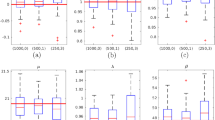Abstract
We show asymptotic distributions of the residual process in Ornstein–Uhlenbeck model, when the model is true. These distributions are of Brownian motion and of Brownian bridge, depending on whether we estimate one parameter or two. This leads to seemingly simple asymptotic theory of goodness of fit tests based on this process. However, next we show that the residual process would lead to a deficient testing procedures, unless a transformed form of it is introduced. The transformed process is introduced and their role is explained through connection with what is known for the so called chimeric alternatives in testing problems for samples.
Similar content being viewed by others
Notes
Scanning through the database MathSciNet with key-word ”Ornstein–Uhlenbeck process” returned first 18 pages, with 20 titles per page, all still dated after year 2000.
In Greek mythology Chimera is a creature which constantly changes, appears and disappears.
References
Abdelrazeq I, Ivanoff BG, Kulik R (2014) Model verification for Lévy-driven Ornstein–Uhlenbeck processes. Electron J Stat 8:1029–1062
Ait-Sahalia Y, Fan J, Peng H (2009) Nonparametric transition-based tests for jump diffusions. J Am Stat Assoc 104:1102–116
Amari S (1985) Differential geometric theory of statistics. In: Lecture notes in statistics, vol 28. Springer, Heidelberg
Barczy M, Pap G (2010) Asymptotic behaviour of maximum likelihood estimator for time inhomogeneous diffusion processes. J Stat Plan Inference 6:1576–1593
Basawa IV, Scott DJ (1983) Asymptotically optimal inference for non-ergodic models, Lecture notes in statistics, vol 17. Springer, Heidelberg
Dachian S, Kutoyants YA (2008) On the goodness-of-fit testing for some continuous time processes. In: Vonta F et al (eds) Statistical models and methods for biomedical and technical systems. Birkhauser, Boston, pp 385–403
Davydov Yu (2001) Remarks on estimation problem for stationary processes in continuous time. Stat Inference Stoch Process 4:1–15
Feigin Paul D (1976) Maximum likelihood estimation for continuous-time stochastic process. Adv Appl Probab 8:712–736
Greenwood P, Shiryaev AN (1985) Contiguity and statistical inference. Gordon and Breach, New York
Janssen A (1995) Principal component decomposition for non-parametric tests. Probab Theory Relat Fields 101:193–209
Hu Y, Nualart D (2009) Parameter estimation for fractional Ornstein–Uhlenbeck processes. arXiv:0901.4925v1
Jiang H (2011) The precise asymptotic behavior of parameter estimators in Ornstein–Uhlenbeck process. J Math Anal Appl 382:367–382
Khmaladze EV (1981) Martingale approach to nonparametric goodness of fit tests. Theory Probab Appl XXVI:240–258
Khmaladze EV (1993) Goodness of fit problem and scanning innovation martingales. Ann Stat 21:798–830
Khmaladze EV (1998) Goodness of fit tests for “chimeric” alternatives. Stat Neerl 51:90–121
Kim YT, Park HS (2017) Optimal Berry-Esseen bound for an estimator of parameter in the Ornstein–Uhlenbeck process (English summary). J Korean Stat Soc 46:413–425
Kleptsina ML, Le Breton A (2002) Statistical analysis of the fractional Ornstein–Uhlenbeck type process. Stat Inference Stoch Process 5:229–248
Kleptsyna ML, Kutoyants YuA (2014) On asymptotically distribution-free tests with parametric hypothesis for ergodic diffusion processes. Stat Inference Stoch Process 17:295–319
Kukush A, Mishura Yu, Ralchenko K (2017) Hypothesis testing of the drift parameter sign for fractional Ornstein–Uhlenbeck process. Electron J Stat 11:385–400
Kutoyants YA (2004) Statistical inference for ergodic diffusion processes, springer series in statistics
Kutoyants YA (2015) On ADF goodness-of-fit tests for perturbed dynamical systems. Bernoulli 21:2430–2456
Lee S, Wee I-S (2008) Residual empirical process for diffusion process. J Korean Math Soc 45(3):683–693
Lin’kov YN (1993) Asymptotic statistical methods for stochastic processes. Naukova Dumka (Translations of Mathematical Monographs, Issue 196). American Mathematical Society, Providence, 2001
Liptser RS, Shiryaev AN (1980) Functional central limit theorem for semimartingales. Theory Probab Appl XXV:683–703
Liptser RS, Shiryaev AN (2001) Statistics of random processes, vol 2. Springer, New York
Martynov GV (1975) Omega-square test. Nauka, Moscow (In Russian)
Masuda H, Negri I, Nishiyama Y (2010) Goodness-of-fit test for ergodic diffusion by discrete-time observations: an innovation martingale approach. J Nonparametr Stat 23:237–254
Negri I, Nishiyama Y (2009) Goodness of fit test for ergodic diffusion process. Ann. Ins. Stat. Math 61:919–928
Pracasa Rao BLS (1999) Statistical inference for diffusion type process. Arnold, Hodder Headline Group, London
Szimayer A, Maller R (2004) Testing for mean reversion in processes of Ornstein–Uhlenbeck type. Stat Inference Stoch Process 7:95–113
Funding
Funding was provided by Marsden Fund (Grant No. VUW13).
Author information
Authors and Affiliations
Corresponding author
Additional information
Publisher's Note
Springer Nature remains neutral with regard to jurisdictional claims in published maps and institutional affiliations.
Rights and permissions
About this article
Cite this article
Khmaladze, E.V. How to test that a given process is an Ornstein–Uhlenbeck process. Stat Inference Stoch Process 24, 405–419 (2021). https://doi.org/10.1007/s11203-020-09233-1
Received:
Accepted:
Published:
Issue Date:
DOI: https://doi.org/10.1007/s11203-020-09233-1




